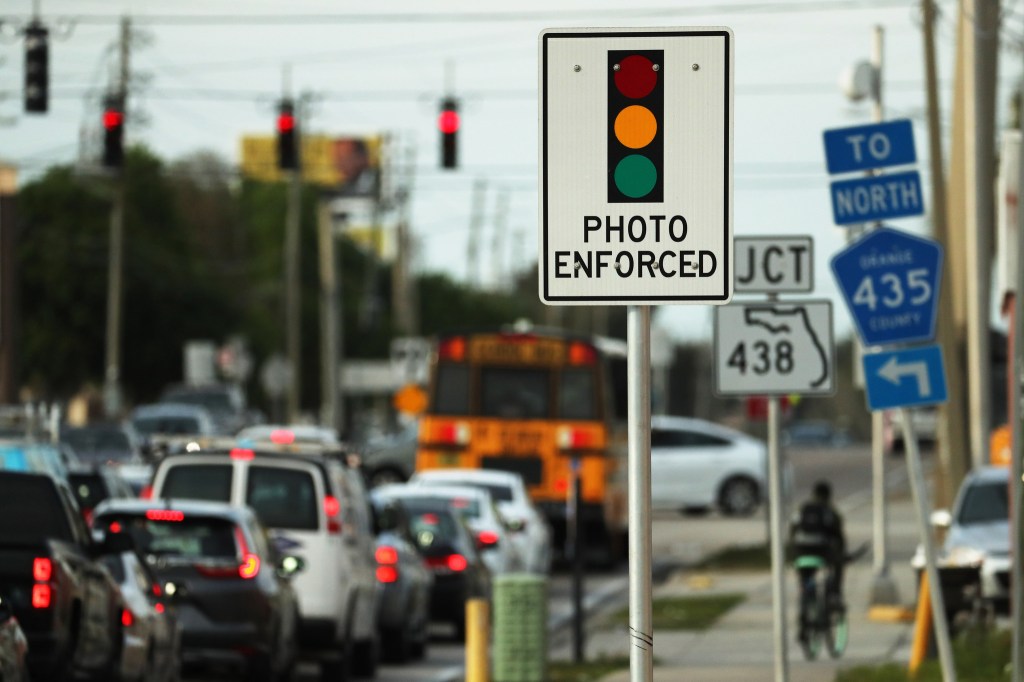Ten years ago, red-light cameras seemed to be everywhere, silent witnesses that tattled on drivers who blew through intersections when they should have stopped. There’s significant evidence that cameras reduce dangerous collisions where they are installed — and there’s no doubt the cameras, which can generate dozens of tickets a day, are big revenue producers for local governments.
But enthusiasm for the devices started to wane as people complained about being ticketed for infractions they didn’t commit, and speculated about whether the private firms contracted to operate the cameras were tinkering with timing to produce more tickets (and revenue). By 2019, local cities including Apopka, Groveland, Casselberry and Clermont had decided to deactivate their cameras. And some state lawmakers were agitating to make the ban universal.
Another shift
But the cameras never completely went away — and now they’re speeding back, accompanied by a new trend that puts speed-detection cameras in school zones. Local cities including Belle Isle, Maitland, Oviedo, Ocoee, Leesburg and Edgewood all have cameras active and generating tickets, and in October, the Orlando City Council approved cameras at 55 intersections that will more than double its current count of 25. They followed that up at Monday’s meeting, adding speed-detecting cameras to 26 school zones. Osceola County has also added school-zone cameras, as have the cities of St. Cloud and Leesburg.
That’s a lot of cameras, and they will translate into a lot of money. In the fiscal year that ended June 30, Orlando issued 60,133 notices of violation from its existing cameras, generating $4.2 million for the city and $3.4 million to the state. That’s according to a report local jurisdictions are required to file with the state if they have a camera-activated ticketing system.
Orlando city leaders have made it clear that revenue is not the driving force behind the cameras. They point to studies showing that installing red-light cameras at intersections reduced the number of crashes by up to 40%, and did even better in preventing the most dangerous side-impact collisions and car-vs.-pedestrian impacts. (Some intersections did have a small uptick in rear-end crashes, but that type of crash is less likely to cause injuries.)
Orlando views its ticket-generating cameras as part of the overall Vision Zero plan, which aims to eliminate traffic deaths in the city. And city officials aren’t using cameras as their sole strategy; they’ve undertaken significant road-improvement programs that make collisions less likelyl
They are relying, however, on that data to justify the tickets. That’s the right approach. Knowing that cameras save lives, it makes sense to use them.
A few safeguards
With that said, there are some things Florida and local governments need to tweak about all ticket-generating cameras. First, they should ensure that the vendors selected to run the camera programs are constantly evaluating their equipment to make sure cameras are accurate and capture the information needed to issue a notice of violation. That’s particularly true of the school-zone speed cameras, which rely on sensitive detection equipment that must be properly calibrated to produce accurate results.
Second, they should do everything possible to ensure that the people being ticketed know they’ve gotten a citation, especially since the clock is running from the time a citation is mailed. It’s easier to ignore one letter in a stack of mail than it is to ignore red and blue flashing lights in your rearview mirror. Ignoring a citation means the offense converts into a standard state of Florida traffic citation, which assesses points against drivers’ licenses and could lead to a license suspension.
This is a significant problem, because of those 60,133 notices of violation that Orlando issued in the most recent fiscal year, a third (20,412) converted into uniform traffic violations. The city didn’t track how many were paid after that, but it’s a safe bet that many drivers never realized they had an outstanding ticket. Florida should look for innovative ways to ensure that drivers are notified. That could include SMS notifications or emails when that information is available — or maybe even an interface that makes a car’s SunPass or E-Pass transponder beep when a red-light camera goes off.
Second, the state should push hard for ways to protect vehicle owners who were not driving their car when it was ticketed — even if the owner can’t or won’t incriminate another driver. Cameras often capture low-resolution video of the person driving the vehicle that ran the light or was caught speeding. When those violations are reviewed, any image that’s not a plausible match with the photo on the vehicle owner’s license should be automatically discarded. AI detection systems could assist with that.
Third, local jurisdictions should do everything possible to ensure that cameras aren’t concentrated in low-income areas if those placements aren’t justified. In recommending the intersections that would get new cameras, Orlando used two criteria. An intersection was automatically included if there had been at least one fatal crash there, or if it scored high on a formula that rated the severity of crashes at a particular intersection. That’s an objective way to consider things, but city leaders will have to brace themselves for a flood of complaints from residents in more affluent areas like Lake Nona, which can expect to get its first red-light cameras in the coming expansion. It’s also obvious from the proposed list that a large number of new cameras will be located in lower-income neighborhoods including Pine Hills and Orlo Vista.
The bottom line is simple: Ticket-generating cameras lead to safer driving, fewer collisions and fewer deaths. So long as they are deployed fairly and checked often for accuracy, they are good tools in the quest to make local roads safer.
The Orlando Sentinel Editorial Board consists of Opinion Editor Krys Fluker, Executive Editor Roger Simmons and Viewpoints Editor Jay Reddick. Use insight@orlandosentinel.com to contact us.

